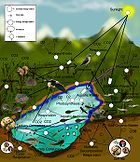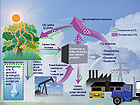- Competitive exclusion principle
-
In ecology, the competitive exclusion principle,[1] sometimes referred to as Gause's law of competitive exclusion or just Gause's law,[2] is a proposition which states that two species competing for the same resources cannot coexist if other ecological factors are constant. When one species has even the slightest advantage or edge over another, then the one with the advantage will dominate in the long term. One of the two competitors will always overcome the other, leading to either the extinction of this competitor or an evolutionary or behavioral shift towards a different ecological niche. The principle has been paraphrased into the maxim "complete competitors cannot coexist".[1]
Contents
Experimental basis
Russian ecologist Georgii Frantsevich Gause formulated the law of competitive exclusion based on laboratory competition experiments using two species of Paramecium, the Paramecium aurelia and Paramecium caudatum. Although the following says that caudatum dominated, the aurelia recovered shortly and attacked the caudatum, completely annihilating the other species. It was a complete surprise, making no sense whatsoever. Following a lag phase, the Paramecium aurelia was consistently able to drive the other to extinction. The conditions were to add fresh water everyday and input a constant flow of food. However, Gause was able to let the Paramecium caudatum survive by driving differently the environmental parameters (food, water). This explains why the Gause law is valid only if the ecological factors are constant. Gause also studied competition between two species of yeast, Saccharomyces cerevisiae and Schizosaccharomyces kefir, and found that Schizosaccharomyces kefir consistently out-competed Saccharomyces cerevisiae by producing a higher concentration of ethyl alcohol.[3]
Prediction
Competitive exclusion is predicted by a number of mathematical and theoretical models, such as the Lotka-Volterra models of competition. However, for reasons that are poorly understood, competitive exclusion is rarely observed in natural ecosystems, and many biological communities appear to violate Gause's Law. The best known example is the paradox of the plankton. All plankton species live on a very limited number of resources, primarily solar energy and minerals that are dissolved in the water. According to the competitive exclusion principle, only a small number of plankton species should be able to coexist on these resources. Nevertheless, large numbers of plankton species coexist within small regions of open sea. Some communities that uphold competitive exclusion are MacArthur's Warblers[4] and Darwin's Finches.[5]
Paradoxical traits
A partial solution to the paradox lies in raising the dimensionality of the system. Spatial heterogeneity, multiple resource competition, competition-colonization trade-offs, and lag prevent exclusion (ignoring stochastic extinction over longer time-frames). However, such systems tend to be analytically intractable. In addition, many can theoretically support an unlimited number of species. A new paradox is created: Most well-known models that allow for stable coexistence allow for unlimited number of species to coexist, yet in nature, any community contains just a handful of species.
Re-definition
Recent studies that address some of the assumptions made for the models predicting competitive exclusion have shown that these assumptions need to be reconsidered. For example, a slight modification of the assumption of how growth and body size are related leads to a different conclusion, namely that for a given ecosystem a certain range of species may coexist while others become outcompeted.[6][7]
One of the primary ways that niche-sharing species can coexist is the competition-colonization trade-off. In other words, species that are better competitors will be specialists, while species that are better colonizers are more likely to be generalists. Host-parasite models are effective ways of examining this relationship, using host transfer events. There seem to be two places where the ability to colonize differs in closely ecologically related species. In feather lice, Bush and Clayton[8] provided some verification of this by showing that two closely related genera of lice are nearly equal in their ability to colonize new hosts pigeons once transferred. Harbison [9] continued this line of thought by investigating whether the two genera differed in their ability to transfer. This research focused primarily on determining how colonization occurs and why wing lice are better colonizers than body lice. Vertical transfer is the most common occurrence, between parent and child, and is well studied and understood. Horizontal transfer is difficult to measure, but in lice seems to occur via phoresis or one species "hitchhiking" on another. Harbison found that body lice are less adept at phoresis and excel competitively, while wing lice excel in colonization.
See also
- Ecological competition
- Joseph Grinnell
- Limiting factor
- Limiting similarity
- Paradox of the plankton
References
- ^ a b Hardin, G. (1960). The Competitive Exclusion Principle. Science 131, 1292-1297.
- ^ Gause, G.F. (1934). The struggle for existence. Baltimore, MD: Williams & Wilkins.
- ^ Gause, G.F. (1932). Experimental studies on the struggle for existence: 1. Mixed population of two species of yeast. Journal of Experimental Biology 9, 389-402.
- ^ MacArthur, R.H. (1958). Population ecology of some warblers of northeastern coniferous forests. Ecology 39, 599-619.
- ^ Lack, D.L. (1945). The Galapagos finches (Geospizinae); a study in variation. Occasional Papers of the California Academy of Sciences 21, 36-49.
- ^ Rastetter, E.B. and Ågren, G.I. (2002). Changes in individual allometry can lead to coexistence without niche separation. Ecosystems 5, 789-801.
- ^ Moll, J.D. and Brown, J.S. (2008). Competition and Coexistence with Multiple Life-History Stages. American Naturalist 171, 839-843.
- ^ Clayton, D.H. and Bush, S.E. (2006). The role of body size in host specificity: Reciprocal transfer experiments with feather lice. Evolution 60, 2158-2167.
- ^ Harbison, C.W. (2008). Comparative transmission dynamics of competing parasite species. Ecology 89, 3186-3194.
- Vaurie, Charles (1950): Notes from the Walter Koelz Collections, Number 6. Notes on some Asiatic nuthatches and creepers. American Museum Novitates '1472': 1-39. PDF fulltext
External links
Categories:- Biological interactions
Wikimedia Foundation. 2010.


